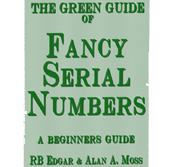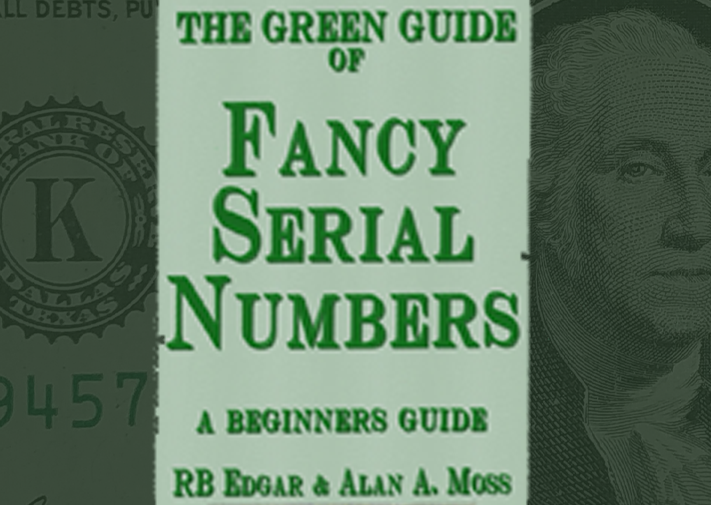Grading
Grading on some Notes can be the difference between having a prized collection
or selling the Note for many times more than just the FSN. Grading is a skill.
It takes a bit of time and knowledge to get a skilled eye, but once you have this
skill, you will never lose it.
Learning to grade is worth your time and best efforts!
There are a ton of resources available to you on how to grade Notes. Here are
some basic explanations to get you going.
1 Poor.
Highly used, damaged, stained, tears, holes, burns, these bills are about as
poor quality as they come before falling into dust. They could fall apart by just
looking at them.
5 Average.
Highly used, damaged, stained, tears, holes, burns, folds, and looks like a failed
oragami project.
10 Good.
These Notes are heavily circulated and have a “weak feel” to the touch. Torn or
roughed up edges, stains, worn out ink areas and holes are common at this level.
15 Very Good.
A tough looking Note, roughed up, lots of folds and creases, corners may have
rounded, but still holds a little stiffness, Note may look “faded” with use.
20 Extremely Good.
Very circulated, lots of folds, creases and “crumpling,” some stiffness remains,
minor defects on the bill but nothing too serious.
25 Fine.
Well circulated, creases and crumpling are common, still has stiffness to the
touch, overall appearance is not dirty, a little “worn” or “faded” is common,
corners and edges are intact.
30 Very Fine.
This bill looks relatively clean, from a few too many folds or creases, edges
and corners appear closer to new than used, no tears, scratches or holes, all ink
connects across the bill.
35 Extra Fine.
Only a couple of wallet folds, no crumpling or origami, edges and corners look
“almost” sharp, no tears or scratches.
40 Good Quality.
Bill is highly crisp to the touch, clean, no stains or damage, a couple to a few
wallet folds, contrast between ink and paper is clear, corners and edges look
sharp to the naked eye.
45 Great Condition.
Barely circulated Note, has high stiffness to the touch, is clean with only one or
two wallet folds, corners and edges are sharp.
50 About Uncirculated.
High stiffness, one or two folds, very clean.
55 About Uncirculated.
High stiffness, clean, only one-fold, edges and corners are sharp.
60 Uncirculated bills and above.
From this level to 70, Notes are uncirculated, and appear as though they
came right from the press. These Notes have no folds or creases, stains, tears,
crumples, tears, roughed up areas, etc.
From 60 and above it is now about the quality of paper (substrate) and the
printing/cutting quality. Although uncirculated, handling at the mint, handling by
collectors, dealers, prospective buyers, storage, humidity, acidic wrappings, and
the hundreds of other things that can happen to a collectible bill come into play
here. The closer too “direct from the press” steps up or steps down the quality
and makes it collectible.
From 60 Unc. to 65 Unc., you can think of the issues listed in percentages, from
“Direct from the press” but with some almost imperceptible flaws,
60 Unc. is about 95% absolute perfect, and 65 Unc. being 98% perfect as if
made by an artisan. Minor things here and there can drop the Note in value.
The differences being very minor from 61 to 62, with the difference from 68 to
70 being so minimally different the percentage difference might be about .05%
different. Think of this scale as 60 being 1.8% different from 61 and 61 being
1.4% different to 62, and when you get into the 68+ range the difference is
incredibly slight of .07% to .04%, it is not a 1 to 1 assessment.
With 70 being created by Picasso or Fabergé, and a 60 being created by a freehanded
pencil artist, at these levels it can be easy to make a small mistake that
can be a dramatic difference at an auction, the more Notes you see, the better
you will be.
60 Uncirculated.
May have some fading, toning issues, ink may not be even across the Note,
some tiny ink smearing, may be off center printing/cutting, handling issues
possible, curling and one or two minor handling issues may be present, defects
in printing or paper creation may be apparent, storage issues may be present,
slight corner and edge issues may be present.
61 Uncirculated.
May have some minor fading/toning issues, ink may not be even across the
Note, some insignificant ink smearing may be present, may be off center
printing/cutting, handling issues possible, curling and one or two minor handling
issues may be present, defects may be apparent, storage issues may be present,
slight corner and edge issues may be present.
62 Uncirculated.
May have some minor fading/toning issues, ink may not be even across the
Note, some insignificant ink smearing may be present, may be off center
printing/cutting, handling issues possible, curling and one or two minor handling
issues may be present, defects may be apparent, storage issues may be present,
slight corner and edge issues may be present.
63 Uncirculated.
May have some slight to minor fading or near imperceptible toning issues, ink
is decently even, some insignificant ink smearing may be present, may be off
center printing/cutting, handling issues possible, monitor curling and one or
two minor handling issues may be present, minor defects may be apparent,
storage issues may be present, slight corner and edge issues may be present.
64 Uncirculated.
May have some slight fading/toning issues, ink is closer to perfectly even, some
near imperceptible ink smearing may be present, may be slightly off-center
printing/cutting, slight handling issues possible, slight curling and one or two
minor handling issues may be present, slight defects may be apparent, slight
storage issues may be present, slight corner and edge issues may be present.
65 Uncirculated and above.
From this point, Notes look perfect to the naked eye, bills will be very close to
perfect center printed and center cut, ink will be highly even and highly centered
across the front and back, there will be no folds, no curling, no stains, and no
toning/contrast issues to the naked eye, these bills will appear “Direct From
Press”, very light handling issues may be present, and now the defects will only
be seen under a 5X power magnifying glass, there will be no acidity stains from
improper storage on older bills.
65 Uncirculated.
Currency may have four or five minor issues under 5x scope, issues can include,
above average cut, above average print, slight mint handling issues, small “Out
of Bounds” ink smears from over inking, mild toning or fading on older bills,
bill will be crisp to the touch.
66 Uncirculated.
Currency may have three or four minor issues under 5x scope, issues can
include, above average cut, above average print, slight mint handling issues,
small “Out of Bounds” ink smears from over inking, very slight toning or fading
on older Notes, bill will be crisp to the touch.
67 Uncirculated.
Currency may have two or three minor issues under 5x scope, issues can
include, above average cut, above average print, slight mint handling issues,
small “Out of Bounds” ink smears from over inking, very slight toning or fading
on older Notes, bill will be crisp to the touch.
68 Uncirculated.
Currency may have one or two super minor issues only seen under 5x scope,
print / cut will be almost perfect, ink may be barely off, very slight handling
issues, very slight toning or fading on older Notes.
69 Uncirculated.
Currency at this level any imperfection no matter how minor, will keep it from a
70. Even one handling issue, ink error, curling, cut / print, anything, just one.
70 Gem ~ Perfect ~ Crisp.
Currency will be perfect, no imperfections or handling/storage issues. Bill is
“Snap Crisp,” perfect printing, perfect cut.
Note: This page contains excerpts and basic information from the book "The Green Guide to Fancy Serial Numbers". Please consider adding a copy to your library, thank you.





